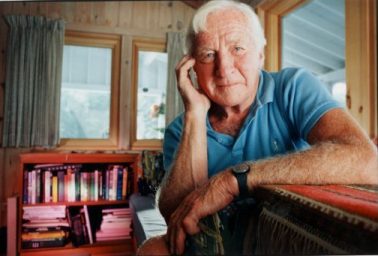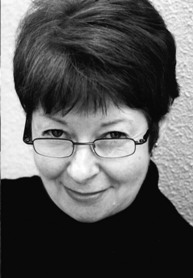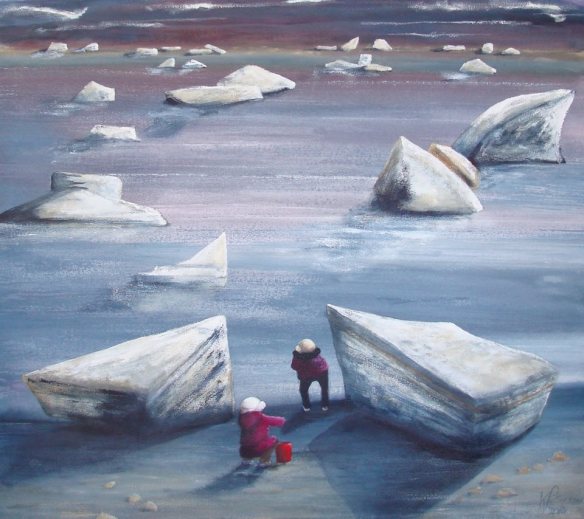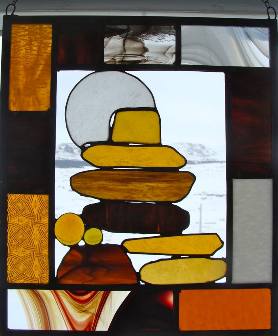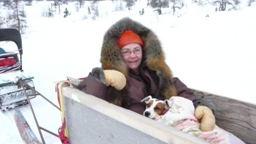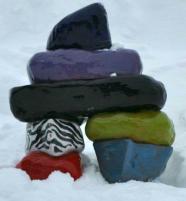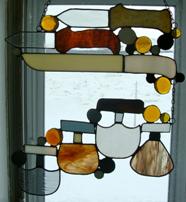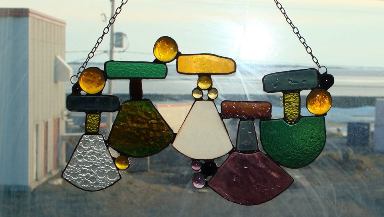(This post, originally published in High North News, was inspired by the presence in the Arctic of significant numbers of Pammy Fleming‘s family, including great4,5,6granddaughters in the Northwest Territories and Nunavik. Credit photo of Nunavut below: Peter Prokosch-Grid Arendal.)
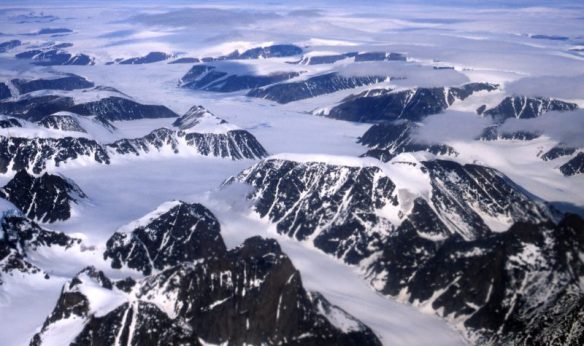 It’s entirely a matter of degree. The North pole at 90°N (North latitude) is as far North as it gets on Earth. The treeline, beyond which trees don’t grow because of ice, snow and cold, is at 50°N in some places. Above 60°N the land is pretty well packed white all winter long. And it’s a long, dark winter.
It’s entirely a matter of degree. The North pole at 90°N (North latitude) is as far North as it gets on Earth. The treeline, beyond which trees don’t grow because of ice, snow and cold, is at 50°N in some places. Above 60°N the land is pretty well packed white all winter long. And it’s a long, dark winter.
To Americans, Canada is a Northern country because Canada lies North of the United States. The U.S.-Canada border dipsy-doodles around 49°N and below (Toronto is at 43°N, Montreal and Ottawa at 45°N). Most Canadians by far — more than nine out of ten — live within 100 miles or about 1.5° of this border. We hug our big neighbour very tightly. (This is true “even in the North,” as Brian Pehora wrote from Whitehorse, Yukon, after this article was first published. “
Canadians are a Northern people we say, guardians of the True North our anthem sings. We’re proud that the tiny hamlet of Alert at 82°N is the place furthest North on the planet that is continuously occupied. Alert’s motto, Inuit Nunangata, means beyond the land of Inuit land. The permanent population of Alert is zero, but there are always a few dozen people there on a rotating basis for weather and military signals monitoring and as a short-term destination for Northern researchers.
But the real truth is that most Canadians by far are a Northern people by reputation only.
Canada’s territory above 60°N measures 4,650,000 square kilometers (46% of Canada) and has a total population of 110,000, more than half aboriginal (about 50,000 Inuit and 15,000 other Indigenous peoples spread among dozens of nations, including Innu, Dene, Métis, Yellowknives, Tlingit, Yukon and Cree). Total GDP for the three Northern territories is just under $10 billion.
Alaska is North for the United States, the largest state in the union by area, with a population of about 750,000, largely employed in gas, oil and government, including the U.S. military, and a GDP of US $45 billion. I won’t belabour the Scandinavians: Helsinki, 1.5 million people at 60°N (all Finns live between 60°N and 70°N), Stockholm with 1.3 million and Oslo with 1.4 million, both at 59°N. Narvik, Norway, with 19,000 people, is situated just above 68°N.
But the real claimant to Northern pre-eminence is Siberia. At just over 13 million sq. km., approximately 10% of Earth’s total land area, Siberia is 77% of Russia, with a population of 40 million. There are big cities in Siberia. The regional admin centre Novosibirsk is at 55°N with more than 1.5 million inhabitants. The longest railway in the world is the Trans-Siberian.
Canada has no cities of any size above 55°N. Edmonton, with a population of 800,000, is at 53°N. North of Edmonton, stretching East and West from the Pacific to Hudson Bay and across to Labrador, you’d have to look hard to find a total of 250,000 people. About a quarter of these are at Fort McMurray (56°N) stripping the Alberta tarsands. Another 60,000 are in the territorial capitals of Yellowknife (60°N), Whitehorse (60°N) and Iqaluit (63°N). The rest are dispersed through dozens of settlements and communities, most with fewer than a thousand inhabitants.
On the other side of the pole a different North is found. Moscow, the Russian capital, sits at 55°N latitude with a population around 11.5 million. St. Petersburg, with five million people, is at 60°N. More than half the area of Russia is still further North, with cities such as Archangel, with 350,000 people at 64°N, Murmansk, with a population of 319,000 at 68°N, Vorcuta, with 75,000 Vorcutans at 67°N and Norilsk, 165,000 at 69°N. Canada has only three hamlets at this latitude, with a total of 1,182 residents.
What southern Canadians must understand is that there’s a lot more experience of the North around the world than we possess. And there’s the rub. Now the North is coming into its own. Now it is the focal point and early warning beacon for global climate change. Now international capital and technology are mobilizing to extract its almost limitless resources. Now shippers see an ice free passage open longer each year in the Northwest, with its promise of faster times and lower costs to move commodities between Asia and Europe. The benign neglect that has kept Canada’s North a private, undeveloped preserve won’t do for tomorrow. It’s high time to re-assess our interests in the North and to work in partnership with its Indigenous peoples.
The October 2013 Throne Speech boasted that, “Canada’s greatest dreams are to be found in our highest latitudes. They are the dreams of a North confident and prosperous.” That was a Conservative speech and the Conservative Prime Minister, Stephen Harper, was an annual visitor to the North, walking the talk as it were.
The current Liberal Prime Minister, Justin Trudeau, hasn’t articulated any significant Northern policy, other than to somehow help Northern residents with the exceptionally high cost of living in lightly populated areas where most food and other supplies have to be flown in. This will no doubt be welcome relief, if and when it happens, but it’s hardly a policy, let alone a strategy. However Mr. Trudeau would hardly disagree with the sentiment, and might feasibly have used it himself if it hadn’t first come from the opposition, that “Canada’s greatest dreams are to be found in our highest latitudes.”
Great dreams perhaps. But do we really have any right to claim great doings?
Search as hard as you can, you won’t find more than $250 million spread over four or five years as evidence of “building the Canadian North,” federal money to be spent on everything from housing to adult education to species protection and harbor and hydro developments. To put that amount in context, it’s the same as was spent recently to renovate the Canadian Museum of Nature along the street from where I live in Ottawa. It’s a pittance in the scheme of Northern development.
Despite the woeful record, we have perfected talking the talk. “The Government of Canada has made the North one of its top priorities. Through our northern strategy, we are working to ensure Canada’s North achieves its full potential as a healthy, prosperous region within a strong and sovereign Canada.”
In response to this delusion, Yevgeny Lukyanov explains what is meant by walking the walk. “For the Russian economy, there are no alternatives for the majority of resources extracted in the North,” says the deputy secretary of the Security Council of the Russian Federation. “These resources provide Russia’s strategic security and will be a determining factor in lifting and modernizing its economy.”
The Russian Arctic produces 11% of the country’s GNP, 93% of its natural gas and 75% of its oil. A good deal of the infrastructure required to further exploit Russia’s Arctic is already in place. In support of resource development, a public-private partnership was concluded December 30, 2015, to build the world’s Northernmost railway, running 170 km Northeast from the Bovanenkovo gas field to the port of Sabetta on the Yamal Peninsula, which will be fully operational by 2016 to provide year-round facilities for vessels carrying goods and gas through the Northern Sea Route. “This project opens a window to the world oceans,” says Irina Sokolova, vice-governor of the Yamal-Nenets Autonomous District. “Its goal is to strengthen the power of Russia in the Arctic frontiers.”
Russia is actively promoting its Northern Sea Route as an alternative to the fabled but elusive Northwest Passage. In fact the most promising and to date the most used way through the Arctic hugs the Russian coast. The Northwest Passage through Canadian waters is narrower, shallower and has more ice.
Russia can deploy 41 icebreakers today and is building 14 more, many of them nuclear-powered. The largest is a 556-foot megaship, 42 feet longer than the next biggest and too big for any existing docks. The United States has only three, one of which has been out of service for repairs for five years. But the U.S. Coast Guard announced January 12, 2016, that it will purchase two new heavy breakers to support operations in the Arctic. They are expected to cost more than US$1 billion apiece and be able to break through ice six feet thick at a speed of three knots, operate for 80 days without refueling and cover about 40,000 kilometers at a speed of 12 knots in ice-free waters.
Canada’s Coast Guard has two decades-old icebreakers heavy enough for thick ice and two medium breakers, all powered by diesel-electric engines. The workhorse has been CCGS Louis S. St-Laurent, almost a half century old. It was due to be replaced next year (2017) by the $1.7 billion CCGS John G. Diefenbaker but this project, announced in 2008, has been repeatedly delayed. The earliest estimate now for the Diefenbaker’s deployment is 2022.
Russia has recently established six new military bases in the Arctic, two of them equipped with anti-aircraft missile systems, and is modernizing six Northern airfields. President Vladimir Putin has said that Russia doesn’t intend to militarize the Arctic but will protect its national interests in oil and gas and maintain an alert against terrorist activity in the region. Last year the largest building in the Arctic, a 14,000-square meter (151,000-square foot) military complex, was completed at Franz Joseph Land, an archipelago of 191 mostly uninhabited islands at 81°N (just 1° south of our Northernmost populated site at Alert).
“For the majority of Russians, the Arctic and everything connected to it is not an abstract concept or romantic exotica, but a practical and vitally important reality,” says Mr. Lukyanov.
For most southern Canadians it is precisely the reverse, a romantic vision, a place dreamed of but difficult to get to and hard to get a grip on. For Northerners and Northern Indigenous peoples, the North is vitally important. On their strength and on their leadership Canada must rely through the difficult Northern century ahead.
To secure this future internationally we must look to the Arctic Council.
The Council is a high-level intergovernmental forum “promoting cooperation, coordination and interaction among the Arctic states, Arctic Indigenous communities and other Arctic inhabitants on common Arctic issues, in particular on issues of sustainable development and environmental protection.” These objectives may either have been strengthened or exceeded last year with establishment of the Arctic Economic Council. The AEC was set up, under Canadian auspices, “as a primary forum for interaction between the Arctic Council and the circumpolar business community.”
The Arctic Council has no power. But it has influence. As the world’s awareness grows of the Arctic’s economic riches and climate risks, that influence is bound to increase. Nobody knows the North better.
As well as Canada, the U.S and Russia, members of the Council include Denmark (pop. 5.6 million), Finland (5.5 million), Iceland (pop. 329,000), Norway (5 million) and Sweden (9.6 million). Membership is open only to nations with territory extending into the Arctic. Many others would like to be involved. Eight European states and China, Japan, South Korea and Singapore have status as Observers and participate in Council working groups. The European Union would like to be an Observer too but has been blackballed by Canada in retaliation for its Brigitte Bardot-inspired ban on seal products. There are also six organizations representing Indigenous peoples throughout the Arctic designated as Permanent Participants of the Council.
All together, the six members of the Council that are not superpowers have a total population lower than California plus Texas. We are never going to outmuscle the giants. But we have a three-to-one voting majority. This will increase in importance as the Council’s authority grows, as surely it will. Outriders will want to get closer to Arctic action. Why is this inevitable? Some non-members of the Council assert that the Arctic belongs to those who have most use for it as well as those who claim sovereignty.
Qu Tanzhou, director of the Chinese Arctic and Antarctic Administration, told an interviewer from the Globe and Mail in January 2014, “Arctic resources, in my opinion, will be allocated according to the needs of the world, not only owned by certain countries. We cannot simply say that this is yours and this is mine.” China has two icebreakers and is expected to commission another this year.
Canada can continue to lead the Arctic Council and solicit the support of non-members, such as China and the European Union, in a new alignment to fulfill the North’s economic potential. We must boost investment in social and economic infrastructure, not by small amounts but by billions.
Above all, the common cause must be to revive and amplify Indigenous strength in the Arctic.
Southern Canadians can rely on their Northern compatriots to hold the North. They won’t hold it alone. But they will be the core, the backbone, of Canadian control in the Arctic. Without them we’ll be frozen out of competition in what is fast becoming a most important focal point of global concern (climate) and interest (resources), in our own backyard.
John Diefenbaker raised the level of Northern consciousness by championing a “roads to resources” vision. But Dief’s program dwindled to nothing during his brief and troubled time in office. Now sixty years later, the time has arrived to do more than walk and talk. Nickel and diming one of the vastest underdeveloped territories of the world is a loser’s strategy. Use it or lose it, China has told us, politely. We should be listening carefully.


